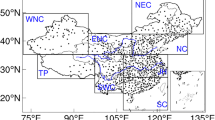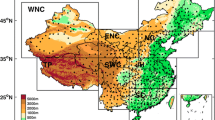Abstract
Using observed surface maximum/minimum temperature and relative humidity (RH) data from 534 meteorological stations in China, the geographical patterns and temporal variations of heat wave (HW) events over the 54 years (1960–2013) were investigated. The HW events were classified into two groups by mean RH: dry HW and wet HW. In total, 211 wet HW events and 64 dry HW events were identified. Wet HW events were commonly located in the southeastern China in the monsoon area, while dry HW events occurred mostly in the northwestern China and North China. Wet HW events occurred from April to September and mostly in July and August, while dry HW events occurred from May to August and mostly in June. The average duration of wet HWs was longer than those of dry HWs, while the average intensity of the wet HWs was lower than those of dry HWs. The annual occurrences of wet HW events and dry HW events increased significantly during 1960–2013, with magnitudes of 0.54 and 0.34 times per decade, respectively. The comprehensive index (C i ) of wet HWs showed a significant positive trend, indicating an increasing severity of wet HWs. The strong wet HW events and dry HW events became more frequent and stronger significantly in the 54 years. The decadal changes in HWs are remarkable, with significant transition points for the frequencies of the wet HWs and dry HWs at 2002 and 1996, respectively. A remarkable increasing trend of frequencies of HWs occurred after the 1990s. Stations with significant positive trends for the annual number of days of the wet HWs were widespread over southern China. The wet HWs in 2003 and 2013 summer were among the top three events in China in the study period, and a large number of sites in East China were affected. The HW event in 2013 lasted shorter and affected less area than that in 2003 but was more intense with higher temperature anomaly during the duration. The more frequent and stronger HW events in the recent years may be partly due to global warming. However, different variations in the dry and wet HW events existed, and possible reasons might be the strong interdecadal and interannual variations in different regional atmospheric circulations.












Similar content being viewed by others
References
Barriopedro D, Fischer EM, Luterbacher J et al (2011) The hot summer of 2010: redrawing the temperature record map of Europe. Science 332:220–224
Beniston M (2004) The 2003 heat wave in Europe: a shape of things to come? An analysis based on Swiss climatological data and model simulations. Geophys Res Lett 31:L02202
Chen RD, Lu RY (2014a) Large-scale circulation anomalies associated with ‘tropical night’ weather in Beijing, China. Int J Climatol 34:1980–1989
Chen RD, Lu RY (2014b) Dry tropical nights and wet extreme heat in Beijing: atypical configurations between high temperature and humidity. Mon Weather Rev 142:1792–1802
China Meteorological Administration (2003) Surface meteorological observation criteria. China Meteorological Press, Beijing (in Chinese)
Christoph S, Gerd J (2004) Hot news from summer 2003. Nature 432:559–560
Della-Marta PM, Luterbacher J, Weissenfluh H et al (2007) Summer heat waves over Western Europe 1880–2003, their relationship to large-scale forcings and predictability. Clim Dyn 29:251–275
Ding T, Ke ZJ (2013) A comparison of statistical approaches for seasonal precipitation prediction in Pakistan. Weather Forecast 28:1116–1132
Ding T, Qian WH (2011) Geographical patterns and temporal variations of regional dry and wet heatwave events in China during 1960–2008. Adv Atmos Sci 28:322–337
Ding T, Qian WH (2012) Statistical characteristics of heat wave precursors in China and model prediction. Chin J Geophys-Chin Ed 55:1472–1486
Ding T, Qian WH, Yan ZW (2009) Changes of hot days and heat waves in China during 1961–2007. Int J Climatol 30:1452–1462
Dole R, Hoerling M, Perlwitz J et al (2011) Was there a basis for anticipating the 2010 Russian heat wave? Geophys Res Lett 38:L06702
Fang XQ, Wang AY, Fong SK et al (2008) Changes of reanalysis-derived Northern Hemisphere summer warm extreme indices during 1948–2006 and links with climate variability. Glob Planet Chang 63:67–78
Gong DY, Pan YZ, Wang JA (2004) Changes in extreme daily mean temperatures in summer in eastern China during 1955–2000. Theor Appl Climatol 77:25–37
Hua LJ, Ma ZG, Zeng ZM (2006) The comparative analysis of the changes of extreme temperature and extreme diurnal temperature range of large cities and small towns in eastern China. Chin J Atmos Sci (Chin) 30:80–91
Huang JY (2004) Meteorological statistical analysis and forecasting method. China Meteorological Press, Beijing (in Chinese)
IPCC (2007) Climate change 2007. Working group I contribution to the fourth assessment report of the IPCC Intergovernmental Panel on Climate Change. Cambridge University Press, Cambridge and New York
IPCC (2013) Climate change 2013: the physical science basis. Contribution of working group I to the fifth assessment report of the Intergovernmental Panel on Climate Change. Cambridge University Press, Cambridge and New York
Levinson DH, Waple AM (2004) State of climate in 2003. Bull Am Meteorol Soc 85:1–72
Li QX, Liu XN, Zhang HZ et al (2004a) Detecting and adjusting temporal inhomogeneity in Chinese mean surface air temperature data. Adv Atmos Sci 21:260–268
Li QX, Zhang HZ, Liu XN et al (2004b) UHI effect on annual mean temperature during recent 50 years in China. Theor Appl Climatol 79:165–174
Liu LL, Sun LH, Liao YM et al (2008) Development and application of national prediction system for extreme high temperature. Meteorol Mon (Chin) 34:102–107
Matzarakis A, Nastos PT (2011) Human-biometeorological assessment of heat waves in Athens. Theor Appl Climatol 105:99–106
Peter D, Jan K, Katarzyna P et al (2003) Variability of extreme temperature events in south-central Europe during the 20th century and its relationship with large-scale circulation. Int J Climatol 23:987–1010
Qian WH, Ding T (2012) Atmospheric anomaly structures and stability associated with heat wave events in China. Chin J Geophys-Chin Ed 55:1487–1500
Qian WH, Lin X (2004) Regional trends in recent temperature indices in China. Clim Res 27:119–134
Radinović D, Ćurić M (2012) Criteria for heat and cold wave duration indexes. Theor Appl Climatol 107:505–510
Ren FM, Cui DL, Gong ZQ et al (2012) An objective identification technique for regional extreme events. J Clim 25:7015–7027
Rummukainen M (2013) Climate change: changing means and changing extremes. Clim Chang 121:3–13
Shi J, Ding YH, Cui LL (2009) Climatic characteristics of extreme maximum temperature in East China and its causes. Chin J Atmos Sci (Chin) 33:347–358
Shi XH, Lu CG, Xu XD (2011) Variability and trends of high temperature, high humidity, and sultry weather in the warm season in China during the period 1961–2004. J Appl Meteorol Climatol 50:127–143
Song X, Zhang Z, Chen Y et al (2014) Spatiotemporal changes of global extreme temperature events (ETEs) since 1981 and the meteorological causes. Nat Hazards 70:975–994
Sterling EM, Arundel A, Sterling TD (1985) Criteria for human exposure to humidity in occupied building. ASHRAE Trans 91:611–622
Tan JG, Song GX, Zheng YF (2006) Heat waves and related mortality in Shanghai in 1998 and 2003. J Environ Health 23:486–488
Trenberth K, Fasullo J (2012) Climate extremes and climate change: the Russian heat wave and other climate extremes of 2010. J Geophys Res 117:D17103. doi:10.1029/2012JD018020
Twardosz R, Kossowska-Cezak U (2013) Exceptionally hot summers in Central and Eastern Europe (1951–2010). Theor Appl Climatol 112:617–628
Unal YS, Tan E, Mentes SS (2013) Summer heat waves over western Turkey between 1965 and 2006. Theor Appl Climatol 112:339–350
Wang HJ, Sun JQ, Chen HP et al (2012) Extreme climate in China: facts, simulation and projection. Meteorol Z 21:279–304
Wang YJ, Ren FM, Zhang XB (2013) Spatial and temporal variations of regional high temperature events in China. Int J Climatol. doi:10.1002/joc.3893
Wei FY (1999) The modern techniques of climate statistical diagnosis and forecast. China Meteorological Press, Beijing (in Chinese)
World Health Organization (2003) The health impacts of 2003 summer heat waves, briefing notes for the delegations of the fifty-third session of the WHO (World Health Organization) regional committee for Europe. Switzerland, Geneva
Yan ZW, Jones PD, Davies TD et al (2002) Trends of extreme temperatures in Europe and China based on daily observations. Clim Chang 53:355–392
Yu YJ (2008) Meteorological condition forecast of heatstroke based on human-environment heat balance model. Dissertation, Nanjing University of Information Science and Technology (in Chinese)
Zhai PM, Pan XH (2003) Trends in temperature extremes during 1951–1999 in China. Geophys Res Lett. doi:10.1029/2003GL018004
Zhang SY, Wang SR, Zhang YS et al (2004) The climate character of high temperature and the prediction in the large cities of east of China. J Trop Meteor (Chin) 20:750–760
Zhang Q, Xu CY, Zhang Z et al (2008) Climate change or variability? The case of Yellow river as indicated by extreme maximum and minimum air temperature during 1960–2004. Theor Appl Climatol 93:35–43
Zheng YF, Yu YJ, Tan JG et al (2007) Influence of meteorological parameters on human comfort index. Meteor Sci Tech (Chin) 35:827–831
Zhou YQ, Ren GY (2011) Change in extreme temperature event frequency over mainland China, 1961–2008. Clim Res 50:125–139
Acknowledgments
This research was supported jointly by the National Natural Science Foundation of China (Grant No. 41205039), the National Basic Research Program of China (973 Program) (Grant 2012CB955902), the National Natural Science Foundation of China (Grant 41005051), and China Meteorological Administration R&D Special Fund for Public Welfare (Meteorology) (Grant GYHY201306024).
Author information
Authors and Affiliations
Corresponding author
Rights and permissions
About this article
Cite this article
Ding, T., Ke, Z. Characteristics and changes of regional wet and dry heat wave events in China during 1960–2013. Theor Appl Climatol 122, 651–665 (2015). https://doi.org/10.1007/s00704-014-1322-9
Received:
Accepted:
Published:
Issue Date:
DOI: https://doi.org/10.1007/s00704-014-1322-9




